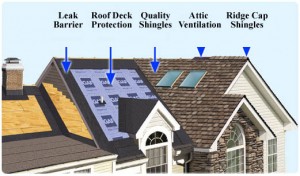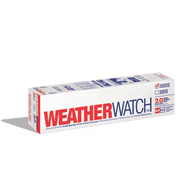Guest Blog: Choosing the right components for your new roofing system
Hello from beautiful Washington State. Chase Construction North West, Inc is privileged to share some helpful information that will help you select your roofing system components.
What should I include in my new roof system?

One of the first components of a roofing system is the sheathing or roof deck. This is usually CDX plywood, OSB, skip sheathing or ship lap. It is imperative that the roof deck is a smooth surface. Irregularities in elevation or sudden pitch transitions can telegraph through the underlayment and shingles. This can affect the aesthetic appearance of the shingle and potentially crack or damage the shingle. If you are re-roofing a proper inspection of the roof deck should be made prior to installing the new roof system. Most roofing contractors will include a provision in the estimate/contract that gives a price (most commonly $45.00 per sheet) to replace rotted sheathing. The amount of rot can only be determined once the roofing has been torn-off.
The next components of your roofing system are roof flashings. Roof flashings are commonly 26 gauge painted steel and come in brown, black or white. Custom colors are available to color match your roof. Perimeter edge metal or eave and rake starter metal is critical to keep wind driven rain from rotting out the sheathing along the edge of your roof. Without these flashings rain pushed by a strong wind can wick back up under the shingle and get trapped between the shingles and sheathing. This will eventually lead to the deterioration of the sheathing. The rake or gable flashing comes with a drip edge flange that propels water away from the fascia board to prevent premature rot. Other important flashings that should be included in your roof system are step metal, back pan metal and roof to wall. These flashings are inserted into critical areas where the roof deck meets a wall, chimney skylight or other penetrations. Without proper flashing your rood will not be water tight and meet warranty standards.
Underlayment is another key component to your new roofing system. The most commonly used underlayments are 15 and 30 pound felt. Felt underlayment’s acts as a vapor barrier protecting the roof deck from harmful heat. Felt is an asphaltic based material and is the most economical of roof deck protection options. Other options for underlayments would be the new synthetic brands such as GAF Tigerpaw. These synthetics are designed to seal around penetrations. They are also breathable aiding in attic ventilation.

The last component of your roofing system is the shingles. Due to technological advancement shingles are now very aesthetic and can add great architectural curb appeal and monetary value to your home. There are several manufacturers such as GAF, Owens Corning, and CertainTeed that produce great quality roofing shingles. Roofing shingles are broken down into 3 categories: Field shingles, starter shingles and hip and ridge shingles. Using factory made pre-cut shingles can add more character and definition to your roofing system. The most commonly used roofing shingles are known as architectural laminates or composition shingles. These shingles are multi-layered with a fiberglass matt, asphalt and special UV resistant granules. If you live in a hail zone region consider using an SBS rubberized shingle such as the Armourshield II which is designed to take the beating of the hail and keep your home protected.
The best way to find out what roofing system is best for your region is to consult with a licensed, bonded and insured roofing contractor from your area. You can find credentialed contractors by checking your local or other agencies like Angies List. Best wishes choosing your new roofing system.
This guest blog was written by Joshua Wilson of Chase Construction North West, Inc. We are certified as 1 of 15 GAF Master Elite Contractors in Washington State. We have been providing quality services as a roofing contractor in Renton, Washington for over 10 years.
Arizona Native Roofing
Email: [email protected]
Website: www.arizonanativeroofing.com
Lakeside Location
2595 Oakleaf Drive
Lakeside, AZ 85929
Office: 928-242-2521
Peoria Location
24008 N 104th Ave
Peoria, AZ 85383
Office: 602-348-6559
Scottsdale Location
5901 E Thunderbird Rd
Scottsdale, AZ 85254
Office: 480-383-9778
Share This Story, Choose Your Platform!
Arizona Native Roofing
Peoria, AZ 85383
Office: 602-348-6559
Email: [email protected]
Website: arizonanativeroofing.com
Office Hours:


